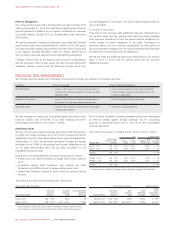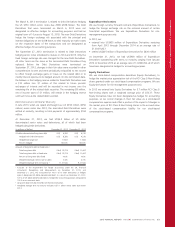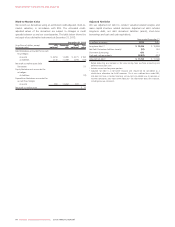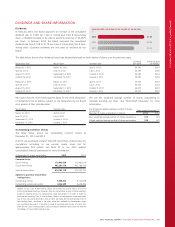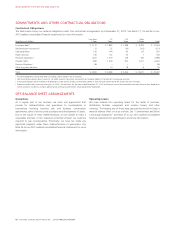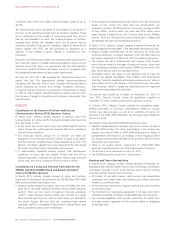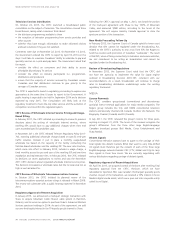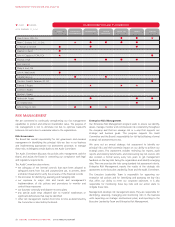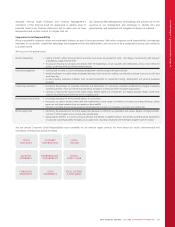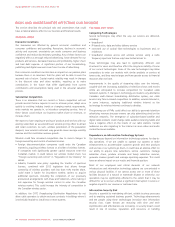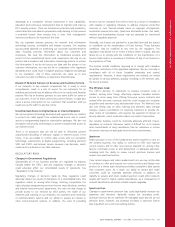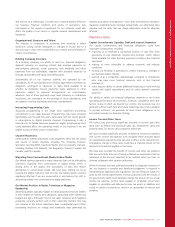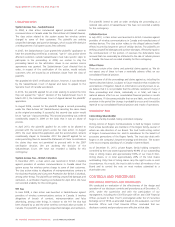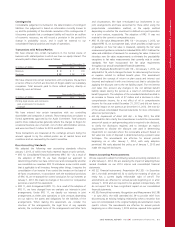Rogers 2013 Annual Report Download - page 76
Download and view the complete annual report
Please find page 76 of the 2013 Rogers annual report below. You can navigate through the pages in the report by either clicking on the pages listed below, or by using the keyword search tool below to find specific information within the annual report.
MANAGEMENT’S DISCUSSION AND ANALYSIS
AUDIT CORPORATE
GOVERNANCE
NOMINATINGHUMAN
RESOURCES
EXECUTIVE FINANCEPENSION
CHAIR MEMBER BOARD OF DIRECTORS AND ITS COMMITTEES
AS OF FEBRUARY 11, 2014
AlanD.Horn
John A. MacDonald
Isabelle Marcoux
ThomasI.Hull
Peter C. Godsoe, O.C., O. Ont.
C. William D. Birchall
Stephen A. Burch
John H. Clappison, FCPA, FCA
Guy Laurence
Philip B. Lind, CM
The Hon. David R. Peterson, PC, QC
Edward S. Rogers
LorettaA. Rogers
MarthaL. Rogers
MelindaM. Rogers
Dr. Charles Sirois
John H. Tory, O. Ont.
, CPA, CA
RISK MANAGEMENT
We are committed to continually strengthening our risk management
capabilities to protect and enhance shareholder value. The purpose of
risk management is not to eliminate risk but to optimize trade-offs
between risk and return to maximize value to the organization.
Risk Governance
The Board has overall responsibility for risk governance and oversees
management in identifying the principal risks we face in our business
and implementing appropriate risk assessment processes to manage
these risks. It delegates certain duties to the Audit Committee.
The Audit Committee discusses risk policies with management and the
Board, and assists the Board in overseeing our compliance with legal
and regulatory requirements.
The Audit Committee also reviews:
• the adequacy of the internal controls that have been adopted to
safeguard assets from loss and unauthorized use, to prevent, deter
and detect fraud and to verify the accuracy of the financial records
• the processes for identifying, assessing and managing risks
• our exposure to major risks and trends and management’s
implementation of risk policies and procedures to monitor and
control these exposures
• our business continuity and disaster recovery plans
• any special audit steps adopted due to material weaknesses or
significant deficiencies that may be identified
• other risk management matters from time to time as determined by
the Committee or directed by the Board.
Enterprise Risk Management
Our Enterprise Risk Management program seeks to ensure we identify,
assess, manage, monitor and communicate risk consistently throughout
the company and that we manage risk in a way that supports our
strategic and business goals. This program supports the Audit
Committee and the Board’s responsibility for risk by facilitating a formal
strategic risk assessment process.
We carry out an annual strategic risk assessment to identify our
principal risks and their potential impact on our ability to achieve our
strategic plans. This assessment includes reviewing risk reports, audit
reports and industry benchmarks, and interviewing key risk owners. We
also conduct a formal survey every two years to get management
feedback on the key risks facing the organization and identify emerging
risks. Then we prioritize the risks using standard risk assessment criteria.
Enterprise Risk Management reports the results of the strategic risk
assessment to the Executive Leadership Team and the Audit Committee.
The Executive Leadership Team is responsible for approving our
enterprise risk policies and for identifying and assessing the key risks
that affect our ability to meet our corporate objectives. It is also
responsible for monitoring these key risks and our action plans to
mitigate these risks.
Management develops risk management plans. They are responsible for
identifying, assessing, managing and monitoring risks in the business
units impacting our strategic and business plans, and reporting to the
Executive Leadership Team and Enterprise Risk Management.
72 ROGERS COMMUNICATIONS INC. 2013 ANNUAL REPORT


